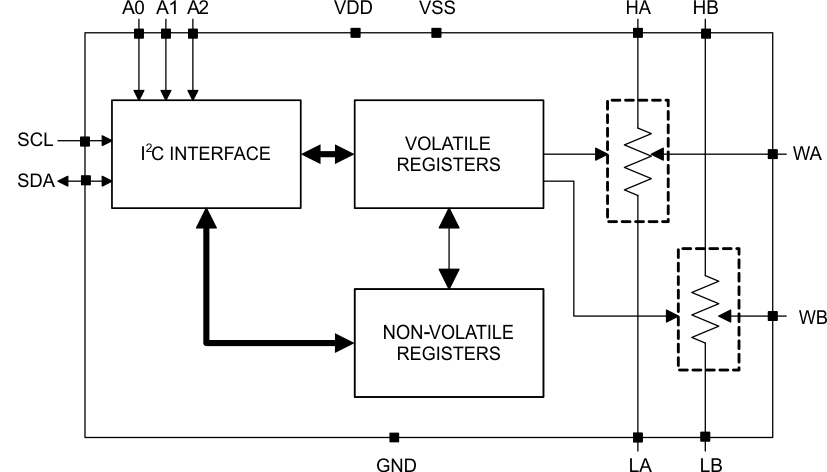SLIS134C March 2011 – September 2015
PRODUCTION DATA.
- 1 Features
- 2 Applications
- 3 Description
- 4 Revision History
- 5 Pin Configuration and Functions
- 6 Specifications
-
7 Detailed Description
- 7.1 Overview
- 7.2 Functional Block Diagram
- 7.3 Feature Description
- 7.4 Device Functional Modes
- 7.5 Programming with I2C
- 7.6
Register Maps
- 7.6.1 Slave Address
- 7.6.2 TPL0102 Register Map
- 7.6.3 IVRA (Initial Value Register for Potentiometer A)
- 7.6.4 WRA (Wiper Resistance Register for Potentiometer A)
- 7.6.5 IVRB (Initial Value Register for Potentiometer B)
- 7.6.6 WRB (Wiper Resistance Register for Potentiometer B)
- 7.6.7 ACR (Access Control Register)
- 8 Application and Implementation
- 9 Power Supply Recommendations
- 10Layout
- 11Device and Documentation Support
- 12Mechanical, Packaging, and Orderable Information
Package Options
Mechanical Data (Package|Pins)
Thermal pad, mechanical data (Package|Pins)
- PW|14
Orderable Information
1 Features
- Two Potentiometers with 256-Position Resolution
- Non-volatile Memory Stores Wiper Settings
- 100 kΩ End-to-End Resistance (TPL0102-100)
- Fast Power-up Response Time to Wiper Setting: <100 µs
- ±0.5 LSB INL, ±0.25 LSB DNL (Voltage-Divider Mode)
- 4 ppm/°C Ratiometric Temperature Coefficient
- I2C-compatible Serial Interface
- 2.7 V to 5.5 V Single-Supply Operation
- ±2.25 V to ±2.75 V Dual-Supply Operation
- Operating Temperature Range from –40°C to 85°C
- Shutdown Mode
- ESD Performance Tested Per JESD 22
- 2000-V Human Body Model (A114-B, Class II)
- 1000-V Charged-Device Model (C101)
2 Applications
- Adjustable Gain Amplifiers and Offset Trimming
- Adjustable Power Supplies
- Precision Calibration of Set Point Thresholds
- Sensor Trimming and Calibration
- Mechanical Potentiometer Replacement
3 Description
The TPL0102 has two linear-taper digital potentiometers (DPOTs) with 256 wiper positions. Each potentiometer can be used as a three-terminal potentiometer or as a two-terminal rheostat. The TPL0102-100 has an end-to-end resistance of 100 kΩ.
The TPL0102 has non-volatile memory (EEPROM) which can be used to store the wiper position. This is beneficial because the wiper position is stored even during power-off and is automatically reinstated after power-on. The internal registers of the TPL0102 can be accessed using the I2C interface.
The TPL0102 is available in a 14-pin MicroQFN and 14-pin TSSOP package with a specified temperature range of –40°C to 85°C.
Device Information(1)
| PART NUMBER | PACKAGE | BODY SIZE (NOM) |
|---|---|---|
| TPL0102 | X2QFN (14) | 2.00 mm × 2.00 mm |
| TSSOP (14) | 5.00 mm × 4.40 mm |
- For all available packages, see the orderable addendum at the end of the data sheet.
Simplified Schematic
